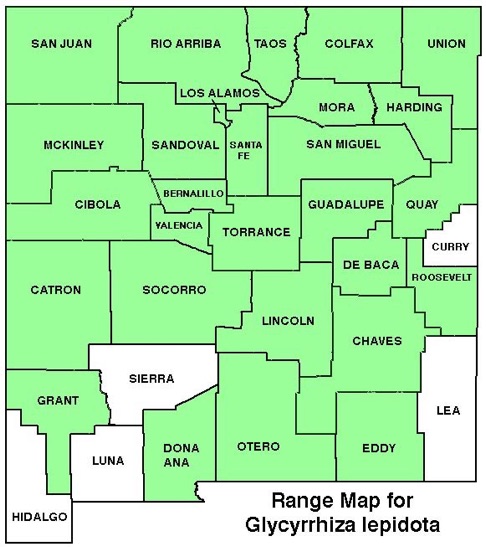WILDFLOWERS OF NEW MEXICO

Spreading by rhizomes, this leafy plant with 1–4-foot tall, erect stems can form dense colonies on roadsides and drainage areas. Note the dense spikes of white, pea-like flowers and bur-like seed pods covered with hooked prickles.
FLOWERS: May–August. Spikes with 20–50 white to creamy, tubular flowers, each 3/8–1/2-inch long (9–13 mm); 5 petals with a narrow, protruding upper banner, 2 side wings, and a short keel. Fruit is a cluster of oblong pods, each 1/2–3/4-inch long (12–20 mm), densely covered with hooked prickles.
LEAVES: Alternate. Blade 3–7 1/2-inches long (8–19 cm), pinnately compound with 13–19 leaflets along the midrib, each 5/16–2 1/8-inches long (8–53 mm), lance-shaped to oblong. Note glandular dots on bottom of leaflets.
HABITAT: Periodically moist sandy, gravelly soils, drainages, stream banks, meadows, roadsides, disturbed areas; desert scrub, pinyon-juniper woodlands.
ELEVATION: 3,500–8,400 feet.
RANGE: Widespread in states west of the Mississippi River.
SIMILAR SPECIES: Most white-flowered milkvetches, Astragalus species, have sprawling rosettes of stems, no glandular dots on leaflets, and no hooked prickles on pods.
NM COUNTIES: Almost statewide in low- to mid-elevation, periodically moist, disturbed habitats: Bernalillo, Catron, Chaves, Cibola, Colfax, De Baca, Dona Ana, Eddy, Grant, Guadalupe, Harding, Lincoln, Los Alamos, McKinley, Mora, Otero, Quay, Rio Arriba, Roosevelt, San Juan, San Miguel, Sandoval, Santa Fe, Socorro, Taos, Torrance, Union, Valencia.









WILD LICORICE
GLYCYRRHIZA LEPIDOTA
Pea Family, Fabaceae
Perennial herb
THE CONTENTS OF THIS WEBSITE ARE COPYRIGHTED AND CANNOT BE USED
WITHOUT PERMISSION OF GEORGE OXFORD MILLER





























































EMAIL ME







